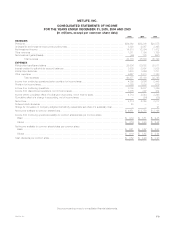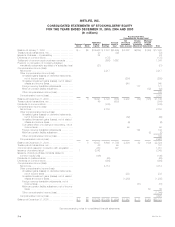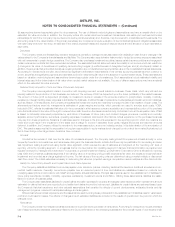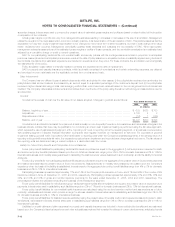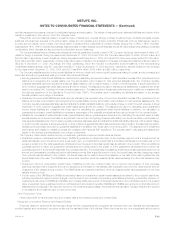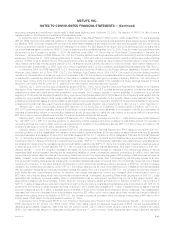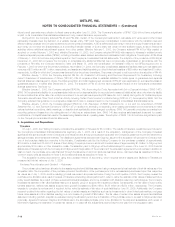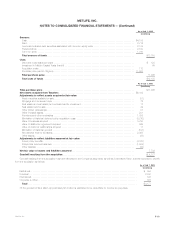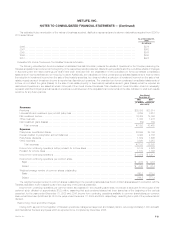MetLife 2005 Annual Report Download - page 75
Download and view the complete annual report
Please find page 75 of the 2005 MetLife annual report below. You can navigate through the pages in the report by either clicking on the pages listed below, or by using the keyword search tool below to find specific information within the annual report.METLIFE, INC.
NOTES TO CONSOLIDATED FINANCIAL STATEMENTS — (Continued)
and risk management programs, reduced for anticipated salvage and subrogation. The effects of changes in such estimated liabilities are included in the
results of operations in the period in which the changes occur.
Policyholder account balances relate to investment-type contracts and universal life-type policies. Investment-type contracts principally include
traditional individual fixed annuities in the accumulation phase and non-variable group annuity contracts. Policyholder account balances are equal to
(i) policy account values, which consist of an accumulation of gross premium payments; (ii) credited interest, ranging from 0.3% to 14% for domestic
business and 1% to 18% for international business, less expenses, mortality charges, and withdrawals; and (iii) fair value adjustments relating to business
combinations. Bank deposits are also included in policyholder account balances.
The Company issues fixed and floating rate obligations under its guaranteed interest contract (‘‘GIC’’) program which are denominated in either U.S.
dollars or foreign currencies. During the years ended December 31, 2005, 2004 and 2003, the Company issued $4,018 million, $3,958 million and
$4,349 million, respectively, in such obligations. During the years ended December 31, 2005, 2004 and 2003, there were repayments of $1,052 million,
$150 million and $47 million, respectively, of GICs under this program. In addition, the acquisition of Travelers increased the balance by $5,293 million in
GICs as of December 31, 2005. Accordingly, the GICs outstanding, which are included in policyholder account balances in the accompanying
consolidated balance sheets, were $17,442 million and $9,017 million at December 31, 2005 and 2004, respectively. Interest credited on the contracts
for the years ended December 31, 2005, 2004 and 2003 was $464 million, $142 million and $58 million, respectively.
The Company establishes future policy benefit liabilities for minimum death and income benefit guarantees relating to certain annuity contracts and
secondary and paid up guarantees relating to certain life policies as follows:
)Annuity guaranteed death benefit liabilities are determined by estimating the expected value of death benefits in excess of the projected account
balance and recognizing the excess ratably over the accumulation period based on total expected assessments. The Company regularly
evaluates estimates used and adjusts the additional liability balance, with a related charge or credit to benefit expense, if actual experience or
other evidence suggests that earlier assumptions should be revised. The assumptions used in estimating the liabilities are consistent with those
used for amortizing DAC, including the mean reversion assumption. The assumptions of investment performance and volatility are consistent with
the historical experience of the Standard & Poor’s 500 Index (‘‘S&P’’). The benefits used in calculating the liabilities are based on the average
benefits payable over a range of scenarios.
)Guaranteed income benefit liabilities are determined by estimating the expected value of the income benefits in excess of the projected account
balance at the date of annuitization and recognizing the excess ratably over the accumulation period based on total expected assessments. The
Company regularly evaluates estimates used and adjusts the additional liability balance, with a related charge or credit to benefit expense, if actual
experience or other evidence suggests that earlier assumptions should be revised. The assumptions used for calculating such guaranteed
income benefit liabilities are consistent with those used for calculating the guaranteed death benefit liabilities. In addition, the calculation of
guaranteed annuitization benefit liabilities incorporates a percentage of the potential annuitizations that may be elected by the contractholder.
)Liabilities for universal and variable life secondary guarantees and paid-up guarantees are determined by estimating the expected value of death
benefits payable when the account balance is projected to be zero and recognizing those benefits ratably over the accumulation period based on
total expected assessments. The Company regularly evaluates estimates used and adjusts the additional liability balances, with a related charge
or credit to benefit expense, if actual experience or other evidence suggests that earlier assumptions should be revised. The assumptions used in
estimating the secondary and paid up guarantee liabilities are consistent with those used for amortizing DAC. The assumptions of investment
performance and volatility for variable products are consistent with historical S&P experience. The benefits used in calculating the liabilities are
based on the average benefits payable over a range of scenarios.
The Company offers certain variable annuity products with guaranteed minimum benefit riders as follows:
)Guaranteed minimum withdrawal benefit riders (‘‘GMWB’’s) guarantee a policyholder return of the purchase payment plus a bonus amount via
partial withdrawals, even if the account value is reduced to zero, provided that the policyholder’s cumulative withdrawals in a contract year do not
exceed a certain limit. The initial guaranteed withdrawal amount is equal to the initial benefit base as defined in the contract. When an additional
purchase payment is made, the guaranteed withdrawal amount is set equal to the greater of (i) the guaranteed withdrawal amount before the
purchase payment or (ii) the benefit base after the purchase payment. The benefit base increases by additional purchase payments plus a bonus
amount and decreases by benefits paid and/or withdrawal amounts. After a specified period of time, the benefit base may also change as a result
of an optional reset as defined in the contract. The benefit base can be reset to the account balance on the date of the reset if greater than the
benefit base before the reset. The GMWB is an embedded derivative, which is measured at fair value separately from the host variable annuity
product.
)Guaranteed minimum accumulation benefit riders (‘‘GMAB’’s) provide the contract holder with a minimum accumulation of their purchase
payments deposited within a specific time period, adjusted proportionately for withdrawals, after a specified period of time determined at the time
of issuance of the variable annuity contract. The GMAB is also an embedded derivative, which is measured at fair value separately from the host
variable annuity product.
)The fair value of the GMWBs and GMABs is calculated based on actuarial and capital market assumptions related to the projected cash flows,
including benefits and related contract charges, over the lives of the contracts, incorporating expectations concerning policyholder behavior. In
measuring the fair value of GMWBs and GMABs, the Company attributes a portion of the fees collected from the policyholder equal to the present
value of expected future guaranteed minimum withdrawal and accumulation benefits. GMWBs and GMABs are reported in policyholder account
balances and the changes in fair value are reported in net investment gains (losses). Any additional fees represent ‘‘excess’’ fees and are reported
in universal life and investment-type product policy fees.
Other Policyholder Funds
Other policyholder funds includes policy and contract claims and unearned policy and contract fees.
Recognition of Insurance Revenue and Related Benefits
Premiums related to traditional life and annuity policies with life contingencies are recognized as revenues when due. Benefits and expenses are
provided against such revenues to recognize profits over the estimated lives of the policies. When premiums are due over a significantly shorter period
MetLife, Inc. F-13


